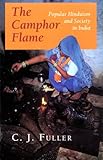The camphor flame : Popular Hinduism and socity in India
Publication details: New Jersey Princeton University Press 1992Description: 306pISBN:- 9780691020846
- 294.509540 FUL
| Item type | Current library | Shelving location | Call number | Status | Date due | Barcode |
|---|---|---|---|---|---|---|
 BOOKs
BOOKs
|
National Law School | Mansfield Section | 294.50954 FUL (Browse shelf(Opens below)) | Not For Loan | 33057 |
Popular Hinduism is shaped, above all, by worship of a multitude of powerful divine beings - a superabundance indicated by the proverbial total of 330 million gods and goddesses. The fluid relationship between these beings and human is a central theme of this rich and accessible study of popular Hinduism in the context of the society of contemporary India. Lucidly organized and skillfully written, "The Camphor Flame" brings clarity to an immensely complicated subject. C.J. Fuller combines ethnographic case studies with comparative anthropological analysis, and draws on textual and historical scholarship as well. The book begins with analysis of "namaskara" - the graceful gesture with which Hindus greet and show respect to gods and goddesses and to social superiors in the human world. Hierarchy is at the heart of Hinduism and Indian society, and Fuller examines the many contexts in which unequal relationships between deities and people, and among people themselves, are expressed - or denied - in popular religion.
Throughout he proposes new ways of looking at many aspects of popular Hinduism and society in India, such as the relationship between worship and sacrifice, the importance of kingship even at the local level, the place of devotionalism in popular religion, the ritual power of goddesses and women, the connection between alternative explanatons of misfortune, and the common basis of rituals that range from the most complicated to the simple showing of a single camphor flame to a god or goddess.

There are no comments on this title.